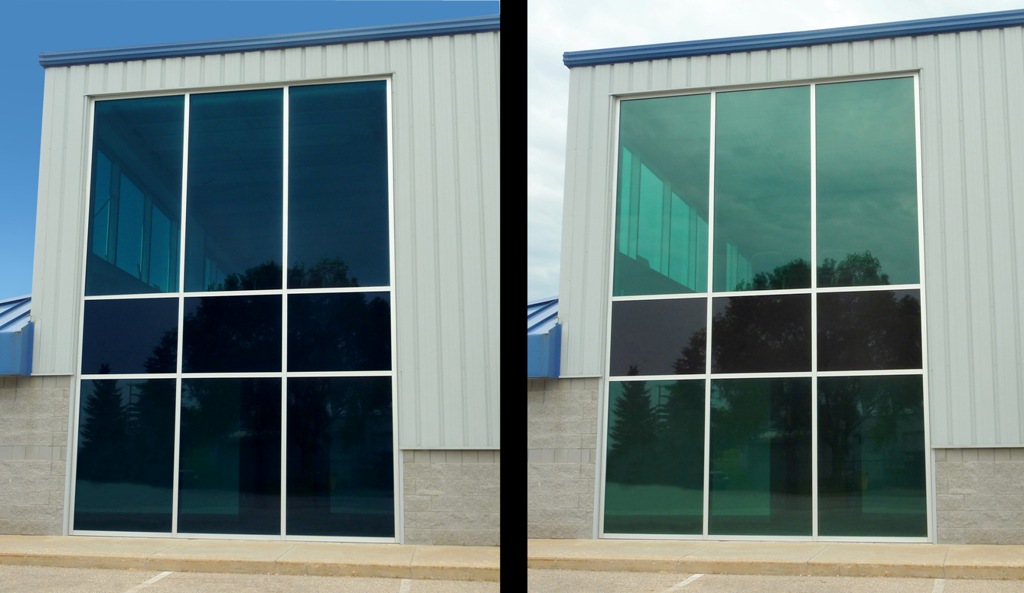PPG Industries and Pleotint, LLC, have agreed to jointly market a commercial window glass system that combines Sunlight Responsive Thermochromic, or SRT, interlayer technology by Pleotint, with Solarban low-emissivity (low-e) glass and other glasses by PPG to control solar heat gain and reduce energy costs in buildings.
Pleotint’s patented technology is a lightly tinted thermochromic interlayer that warms up and darkens in direct sunlight, but clears in indirect sunlight to allow light to pass into a building. Laminated between two lites of glass, SRT interlayer may be used monolithically or within an insulating glass unit. Visible light transmittance for windows with SRT interlayer adjusts through the day without the need for wiring, power supplies or controls.
When the SRT interlayer is combined in a window system with Solarban glass, a proven solar control, low-e glass that also blocks solar heat and transmits visible light, these adaptive windows can dramatically reduce the amount of energy required to cool buildings. Because the windows clear up in indirect sunlight, they also decrease the need for artificial lighting.
A study showed that, due to its ability to dynamically adjust to natural lighting conditions, a window system including an SRT interlayer can reduce energy costs in commercial buildings by 17 to 30% over industry-standard window systems. A window with SRT technology also reduces the transmittance of ultraviolet light and short-wavelength visible light, which are major contributors to fading in carpets, fabrics, artwork, photos and other materials.
Unlike competing dynamic windows that require manual, electrical or mechanical controls, windows with the SRT interlayer use the sun’s own energy – up to 1,000 watts of power per square meter – to adjust the window tint and transmittance level. Because the process is entirely self-sustaining, the SRT interlayer system not only uses less energy, it also eliminates the opportunities for failure due to faulty wiring, poor connections or broken electrical circuits. Windows with SRT interlayers also have passed exposure and durability testing developed for electrochromic windows and conducted by the National Renewable Energy Laboratory (NREL).
Insulating units with SRT interlayers and Solarban low-e glass are available in sizes up to 5 feet wide and have been laminated in lengths of up to 11 feet. Architects may specify any Oceans of Color tinted glass or Earth and Sky high-performance tinted glass by PPG as a base-state window color. BD+C
Related Stories
Retail Centers | May 3, 2024
Outside Las Vegas, two unused office buildings will be turned into an open-air retail development
In Henderson, Nev., a city roughly 15 miles southeast of Las Vegas, 100,000 sf of unused office space will be turned into an open-air retail development called The Cliff. The $30 million adaptive reuse development will convert the site’s two office buildings into a destination for retail stores, chef-driven restaurants, and community entertainment.
Codes and Standards | May 3, 2024
New York City considering bill to prevent building collapses
The New York City Council is considering a proposed law with the goal of preventing building collapses. The Billingsley Structural Integrity Act is a response to the collapse of 1915 Billingsley Terrace in the Bronx last December.
Architects | May 2, 2024
Emerging considerations in inclusive design
Design elements that consider a diverse population of users make lives better. When it comes to wayfinding, some factors will remain consistent—including accessibility and legibility.
K-12 Schools | Apr 30, 2024
Fully electric Oregon elementary school aims for resilience with microgrid design
The River Grove Elementary School in Oregon was designed for net-zero carbon and resiliency to seismic events, storms, and wildfire. The roughly 82,000-sf school in a Portland suburb will feature a microgrid—a small-scale power grid that operates independently from the area’s electric grid.
AEC Tech | Apr 30, 2024
Lack of organizational readiness is biggest hurdle to artificial intelligence adoption
Managers of companies in the industrial sector, including construction, have bought the hype of artificial intelligence (AI) as a transformative technology, but their organizations are not ready to realize its promise, according to research from IFS, a global cloud enterprise software company. An IFS survey of 1,700 senior decision-makers found that 84% of executives anticipate massive organizational benefits from AI.
Codes and Standards | Apr 30, 2024
Updated document details methods of testing fenestration for exterior walls
The Fenestration and Glazing Industry Alliance (FGIA) updated a document serving a recommended practice for determining test methodology for laboratory and field testing of exterior wall systems. The document pertains to products covered by an AAMA standard such as curtain walls, storefronts, window walls, and sloped glazing. AAMA 501-24, Methods of Test for Exterior Walls was last updated in 2015.
MFPRO+ News | Apr 29, 2024
World’s largest 3D printer could create entire neighborhoods
The University of Maine recently unveiled the world’s largest 3D printer said to be able to create entire neighborhoods. The machine is four times larger than a preceding model that was first tested in 2019. The older model was used to create a 600 sf single-family home made of recyclable wood fiber and bio-resin materials.
K-12 Schools | Apr 29, 2024
Tomorrow's classrooms: Designing schools for the digital age
In a world where technology’s rapid pace has reshaped how we live, work, and communicate, it should be no surprise that it’s also changing the PreK-12 education landscape.
Adaptive Reuse | Apr 29, 2024
6 characteristics of a successful adaptive reuse conversion
In the continuous battle against housing shortages and the surplus of vacant buildings, developers are turning their attention to the viability of adaptive reuse for their properties.
AEC Innovators | Apr 26, 2024
National Institute of Building Sciences announces Building Innovation 2024 schedule
The National Institute of Building Sciences is hosting its annual Building Innovation conference, May 22-24 at the Capital Hilton in Washington, D.C. BI2024 brings together everyone who impacts the built environment: government agencies, contractors, the private sector, architects, scientists, and more.

















